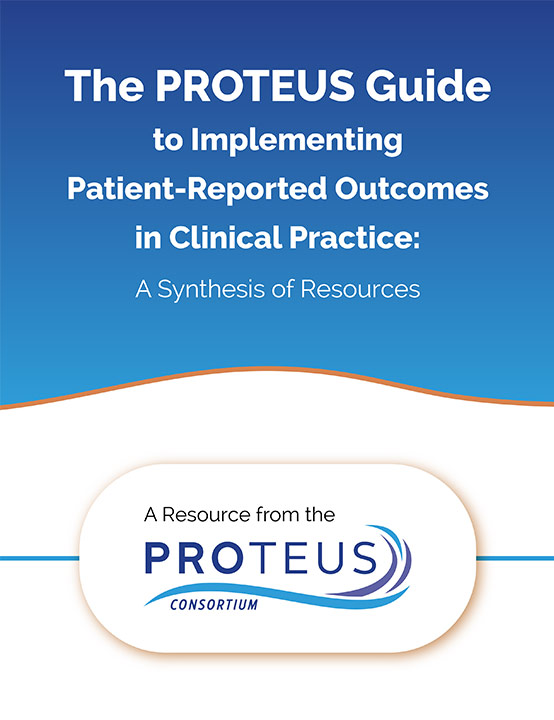PROTEUS — PRACTICE
Determining Administration Timing/Frequency: Chapter 6
In this excerpt (Chapter 6) from the PROTEUS-Practice Guide, you’ll learn when and how to collect patient-reported outcome measures (PROMs) based on your system’s goals.
This webpage contains the entire contents of Chapter 6. You can also download the PROTEUS-Practice Guide by clicking here.
Key Points
- Patient-reported outcome measures (PROMs) can be completed at a single clinical visit, at multiple clinical visits, between visits through remote monitoring, or some combination of the above
- The best timing and frequency of collecting PROMs will vary depending on the PRO system’s data collection goals
Overview
The optimal timing and frequency of collecting PROMs will vary depending on the PRO system’s data collection goals. PROMs can be collected in the clinic at a single visit or over repeated visits. While collecting information at a single visit can be useful in screening for problems and unexpected conditions, it does not allow for monitoring over time.
Collecting PROMs at multiple visits is useful for evaluating a patient’s trajectory over time and may be particularly useful to inform clinical care if a patient is symptomatic. However, increasing the number of instances of PROM collection requires an incremental increase in resources, and can be burdensome to patients.
PROMs can also be collected remotely between clinic visits, and while this approach may decrease disruptions to the clinical workflow at the visit, it requires patients to have both the willingness to complete PROMs outside of the clinical encounter and to have the ability to access the patient portal or other PRO collection system. It also requires a process for managing the incoming PRO data outside of the clinic visit workflow.
Questions and Considerations
A. When can PROMs be completed?
At a clinic visit: single visit
- Provides an opportunity to screen for problems and unexpected health conditions with relatively low burden to patients
- Provides the care team information about what is important to the patient
- Does not allow for monitoring changes over time
- May be more appropriate for patients with stable health
At a clinic visit: multiple visits
- Allows for better understanding of the patient’s trajectory and can provide a more complete picture of the patient’s health. This information may be especially useful for patients who are symptomatic or in treatment
- May help patients better understand the interpretation of the PRO scores and how they align with their health and functional status
- Increases the resources required to collect PROMs incrementally based on the frequency of PROM collection
- May be more burdensome to patients, but may also provide information that is valuable to patients about their health over time
Between visits (remotely)
- Generally, requires patients to have access to the internet for completion via the patient portal or other platform outside of the clinical setting; can also be done via telephone administration (live or automated); use of mailed surveys limits ability to act on data in real-time
- Has the potential to help patients connect with care as needed between visits, and can help inform whether a patient needs care even when not being seen by the clinical team
- Requires a workflow to monitor PROM responses to determine whether they are clinically actionable or necessitate an alert to a member of the care team
- Creates the potential for burdensome alerts to the clinical care team, if they are triggered too often or for changes that are not clinically meaningful
- Requires patient willingness to engage with the PRO system outside of the clinic, and may result in decreased completion rates
Relevant Primary Resources
The information presented here is an overview of PROM administration timing/frequency. For more detailed information please see the following sources:
Background And Citing The Proteus-Practice Guide
Nothing in this Guide should be construed to represent or warrant that persons using this Guide have complied with all applicable laws and regulations. All individuals and organizations using this template have the responsibility for complying with the applicable laws and regulations or regulatory requirements for the relevant jurisdiction.
Each chapter of the Guide lists the key foundational resources that informed its content. To appropriately recognize the foundational resources, we encourage you to cite both the Guide and the relevant foundational resource(s). Recommended citations are provided here.
Suggested Citation
The PROTEUS Guide to Implementing Patient-reported Outcomes in Clinical Practice
A synthesis of resources. Prepared by Crossnohere N, Brundage M, Snyder C, and the Advisory Group, 2023. Available at: TheProteusConsortium.org.
Further Reading
The Guide draws primarily from the foundational resources cited in each chapter. Please click here to find a selection of other relevant references.

